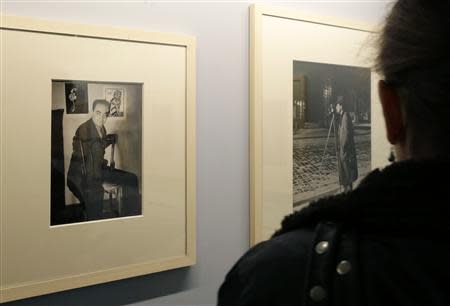Show of Brassai photographs captures light and shade of Paris
By Alexandria Sage PARIS (Reuters) - Two lovers embrace on a double-sided bench, the backs of their heads illuminated by the garish light of a Paris gas lamp. But a second glance at the 1931-32 Brassai photograph reveals a more tawdry, though no less evocative image: an ageing tramp with disheveled hair sleeping on the other side. Light and shadow, romance and seediness, youth and age - these are the contrasting elements brought to life by Brassai during more than 50 years photographing Paris, presented in "Brassai - For the Love of Paris", opening on Friday at Paris's city hall. These are images of a bygone era whose central characters - workers gathered around zinc-topped bars, prostitutes lingering in doorways, or vegetable sellers surrounded by mounds of carrots and leeks at the pre-dawn Les Halles market - are always illuminated by ambient light. "(Brassai) shows an obvious taste for thick fog and waits until the gas lamps, the car headlights or the glow of cigarettes ... reveal their subjects like ghostly apparitions," read the exhibition notes. Called the "living eye" by his friend, the American author Henry Miller, Brassai was born Gyulus Halasz on September 9, 1899, in the city of Brasov - then part of the Kingdom of Hungary and now in Romania. Arriving in Paris in 1925, he adopted the pseudonym Brassai as he ventured into journalism, and picked up a camera four years later for photographs to accompany his articles. He remained in Paris until his death in 1984. "Curiously, when he arrived in Paris, he never went back to Hungary. That was the first question I asked myself: Why?" said the show's curator, Agnes de Gouvion Saint-Cyr. "For me, Paris and Brassai is a love story, like the madeleine (cup cake) and Marcel Proust." GARGOYLES AND SHOW GIRLS Brassai's love for Paris, a city also revered by his fellow photographers Eugene Atget, Andre Kertesz, Henri Cartier-Bresson and Robert Doisneau, best unfolds at night. Whether his series of rainy cobblestone streets, the gargoyles of Notre-Dame cathedral keeping watch over the city below, or the bridges of Paris framed by the nude trunks of trees along the banks of the Seine - the photographs reveal a haunting, elusive beauty that still captivates today. "I was in search of the poetry in the fog that transformed things, the poetry of the night that transforms the city, the poetry of the weather that transforms beings," Brassai said. Driven by "the urgency to photograph a Paris that might disappear", according to de Gouvion Saint-Cyr, Brassai set about capturing the humble pleasures of the working class of the 1930s. Bars, cafes, music halls such as the Folies Bergeres, even the "Chez Suzy" bordello, all served as backdrops for Brassai's camera, as he sought out the city's butchers and bums, shop girls and street thugs. But Brassai also hobnobbed with the leading artists of his era, including the Surrealist poets Andre Breton and Paul Eluard, and Pablo Picasso. The Spaniard shared with the photographer a love of the circus, and of animals - a 1944 Brassai image shows Picasso's Afghan hound, Kazbek, lounging on a small Persian rug in the artist's studio, surrounded by paintings and brushes. The exhibition, which runs to March 8, also includes a 21-minute film shot by Brassai in 1956. "As Long as There are Animals" went on to win the Most Original Film award at the Cannes Film Festival. (Reporting by Alexandria Sage; Editing by Kevin Liffey)





